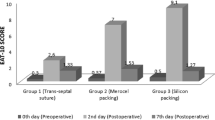Abstract
Septoplasty is one of the most common operations performed in otolaryngology and anterior nasal packing is done routinely to prevent postoperative bleeding, septal hematoma or nasal synechia. Currently, transseptal sutures have gained a broader application area, not only for preventing the complications such as septal hematoma and bleeding but also closing any accidental tears of septal mucosa and providing additional support for the cartilage pieces retained in septoplasty. We evaluated the quality of life of the patients in early postoperative period (in the first postoperative week), intranasal edema with endoscopic examination and the intranasal changes with acoustic rhinometry. We performed a prospective and randomized study with patients undergoing septoplasty without inferior turbinectomy. As packing material, there were two groups: in group A, gauze in a glove finger and in group B, Doyle splint were used, and in the additional group C, only transseptal suture with 4/0 vicryl among the cartilaginous septum was performed. The patients were invited to control examinations on the postoperative 2nd, 4th and 7th days to evaluate the scores from 1 to 5 on the questionnaire for the pain, nasal fullness, sneezing, epiphora, difficulty in swallowing and sleep disturbances. The patients were also administered an endoscopic nasal examination for the purpose of detecting the intranasal edema, and acoustic rhinometry was performed during the control examinations to detect the intranasal changes. Total occluding packing was found to cause much more frequent and higher scores of epiphora, sneezing, difficulty in swallowing, but mainly, the pain compared to in silicone packing with airway and transseptal suture only. Although the silicone packing with airway was found to be much more comfortable, it also led to sneezing and epiphora. The patients without nasal packing had more comfortable period especially in the early postoperative days (the first 4 days). However, 1 week after surgery, groups with and without nasal packing were found to be equalized on behalf of the objective and subjective parameters. As any complication was not observed due to not using nasal packing, it is thought that nasal packing usage following septoplasty is not a necessity.



Similar content being viewed by others
References
Bernardo MT, Alves S, Lima NB, Helena D, Condé A (2013) Septoplasty with or without postoperative nasal packing? Prospective study. Braz J Otorhinolaryngol 79(4):471–474
Basavaraj N, Walikar S, Rashinkar MS, Kakkeri A (2011) A comparative study of septoplasty with or without nasal packing. Indian J Otolaryngol Head Neck Surg 63(3):247–248
Gunaydin RO, Aygenc E, Karakullukcu S, Fidan F, Celikkanat S (2011) Nasal packing and transseptal suturing techniques: surgical and anaesthetic perspectives. Eur Arch Otorhinolaryngol 268(8):1151–1156
Ardehali MM, Bastaninejad S (2009) Use of nasal packs and intranasal septal splints following septoplasty. Int J Oral Maxillofac Surg 38(10):1022–1024
Acıoğlu E, Edizer DT, Yiğit Ö, Onur F, Alkan Z (2012) Nasal septal packing: which one? Eur Arch Otorhinolaryngol 269(7):1777–1781
Gioacchini FM, Alicandri-Ciufelli M, Kaleci S, Magliulo G, Re M (2014) The role of antibiotic therapy and nasal packing in septoplasty. Eur Arch Otorhinolaryngol 271(5):879–886
Cayonu M, Acar A, Horasanlı E, Altundag A, Salihoglu M (2014) Comparison of totally occlusive nasal pack, internal nasal splint, and transseptal suture technique after septoplasty in terms of immediate respiratory distress related to anesthesia and surgical complications. Acta Otolaryngol 134(4):390–394
Cukurova I, Cetinkaya EA, Mercan GC, Demirhan E, Gumussoy M (2012) Retrospective analysis of 697 septoplasty surgery cases: packing versus trans-septal suturing method. Acta Otorhinolaryngol Ital 32(2):111–114
Ogretmenoglu O, Yilmaz T, Rahimi K, Aksöyek S (2002) The effect on arterial blood gases and heart rate of bilateral nasal packing. Eur Arch Otorhinolaryngol 259(2):63–66
Fairbanks DN (1986) Complications of nasal packing. Otolaryngol Head Neck Surg 94(3):412–415
Korkut AY, Erkalp K, Erden V, Teker AM, Demirel A, Gedikli O, Saidoglu L (2010) Effect of pharyngeal packing during nasal surgery on postoperative nausea and vomiting. Otolaryngol Head Neck Surg 143(6):831–836
Naghibzadeh B, Peyvandi AA, Naghibzadeh G (2011) Does post septoplasty nasal packing reduce complications? Acta Med Iran 49(1):9–12
Weber R, Keerl R, Hochapfel F, Draf W, Toffel PH (2001) Packing in endonasal surgery. Am J Otolaryngol 22(5):306–320
Tomori Z, Widdicombe JG (1969) Muscular, bronchomotor and cardiovascular reflexes elicited by mechanical stimulation of the respiratory tract. J Physiol 200(1):25–49
Author information
Authors and Affiliations
Corresponding author
Ethics declarations
Conflict of interest
Each of the authors declares that there is not any conflict of interest.
Ethical approval
This research was approved by Hacettepe University Ethics Board (No. 2014/06-06, KA-14021).
Informed consent
Informed consent was obtained from all individual participants included in the study.
Rights and permissions
About this article
Cite this article
Kayahan, B., Ozer, S., Suslu, A.E. et al. The comparison of the quality of life and intranasal edema between the patients with or without nasal packing after septoplasty. Eur Arch Otorhinolaryngol 274, 1551–1555 (2017). https://doi.org/10.1007/s00405-016-4403-9
Received:
Accepted:
Published:
Issue Date:
DOI: https://doi.org/10.1007/s00405-016-4403-9




